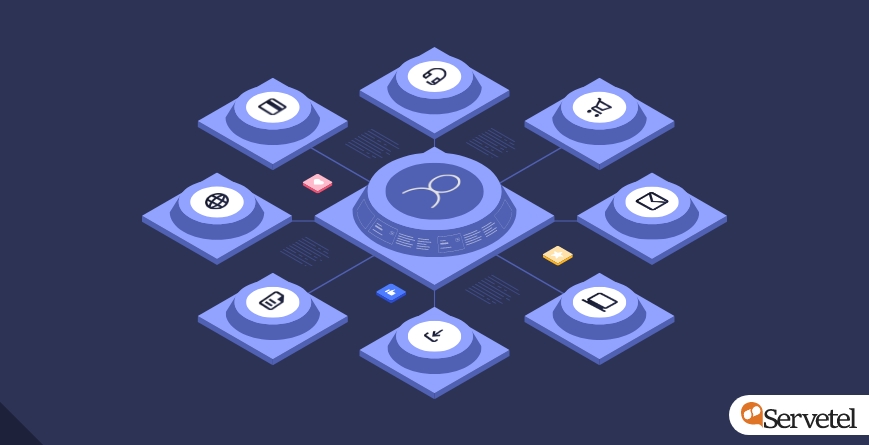Curated personalisation in the virtual world is clearly the next frontier of communications. While several tools come to aid in this effort, omnichannel platforms are now imperative for smooth and seamless customer service delivery for customers.
With information becoming the most important currency in the digital age, companies have started to store and leverage vast customer databases. This data is then used to finetune service offerings in line with individual preferences.
However, in a world where customers use multiple devices, keeping track of data becomes a tedious and repetitive task. To solve this problem, businesses have started to employ omnichannel solutions and maintain a seamless flow of customer data.
Let us learn more about omnichannel personalisation.
What is omnichannel personalisation?
Customers are everywhere—from retail stores to online shopping. In all of their transactions, they leave a digital footprint. This can include product preferences, the preferred mode of contact, and the likes.
All of this data is extremely valuable for businesses to provide a smooth customer experience.
With an omnichannel solution, they’re able to maintain a cohesive report on all this data and store it in a single, easy-to-access place. And armed with this information, contact centre agents can provide the service modern customers demand and expect from brands.
Embracing digital personalisation exponentially enhances customer experience and helps turn general audiences into loyal customers.
Omnichannel trends for 2022
Considering how valuable omnichannel personation has become in the present day and age, it is important to understand the trends and changes for the year 2022 and beyond.
-
Zero and first-party data
With cookies on web pages declining in popularity due to stricter privacy measures, first-party and zero-party data have gained further traction. Zero-party data generally involves data collected by brands on their channel in the form of feedback and suggestions.
First-party data, on the other hand, involves data collected from the actions of customers. This includes activities like browsing products they like, or adding them to their wish lists or carts.
-
Defined strategy and feedback loop
Most brands and companies have an in-depth understanding of customer journey, successfully generating enough awareness even before the customer has approached the business.
There is also a focus on gathering zero-party data through customer feedback and suggestions to constantly improve service offerings.
-
Technology-enabled special experiences
Technological advances are reshaping buyer journeys. With e-commerce gaining mass adoption in the last decade, eyes are now set on other areas to identify reas that can be improved with the help of technology.
Tools like QR codes are already replacing traditional jobs like those of cashiers. With automated inventory uploads, customers can now simply enter a store and make all transactions online.
Such tools enable cashless operations, giving customers a smooth and hassle-free experience.
-
Leveraging digital footprints
Every time you browse for anything on the Internet, you leave your digital footprint behind. This can include data about your past website visits or, for some, personal information like names, addresses and telephone numbers.
Companies using omnichannel customer personalisation can scout for footprint left by leads and buyers on other channels and use them to deliver targeted ads and other information to the customer.
Leveraging digital footprints is a great way to increase the chances of conversion.
-
Post-pandemic applicability
The pandemic has significantly altered buyer behaviour and journey. A considerable portion of customers now prefers online purchases and cashless payments over offline processes.
This shift has further increased the need for simple data collection from various sources—email, social media, text messages.
Benefits of omnichannel personalisation
Given the several benefits of omnichannel personalisation, its mass adoption by major companies doesn’t come as a surprise. Some core advantages include:
-
Value increase
Brands are likely to see a substantial increase in customer buying value through the use of targeted data points. Offering a smoother customer journey results in an increase of both traffic and commerce on their website and other channels.
-
Higher conversion rates
Omnichannel solutions have a high return on investment.
Customers that experience seamless services are likelier to return to your brand. This helps not only build a larger customer base, but also helps businesses augment their customer retention.
-
Personalised experience
Customers are more likely to purchase from brands that offer one-to-one solutions for their products and support. An increase in customer satisfaction and personalised customer experiences is directly linked to the establishment of repeat customers.
Conclusion
In today’s hyper-connected world, agile, flexible and personalised experiences have become extremely important for businesses hoping to build a loyal customer base.
In the post-pandemic landscape, businesses will have to ensure that they continue to offer an omnichannel, personalised customer experience. They will also have to thoroughly analyse the data collected from different sources.
Doing so will not only facilitate smoother customer journeys, but also allows for an improved relation between the consumer and your business, ultimately affecting your bottom line and growing your clientele.
Contact our experts at [email protected] or 1800-120-4132.
















